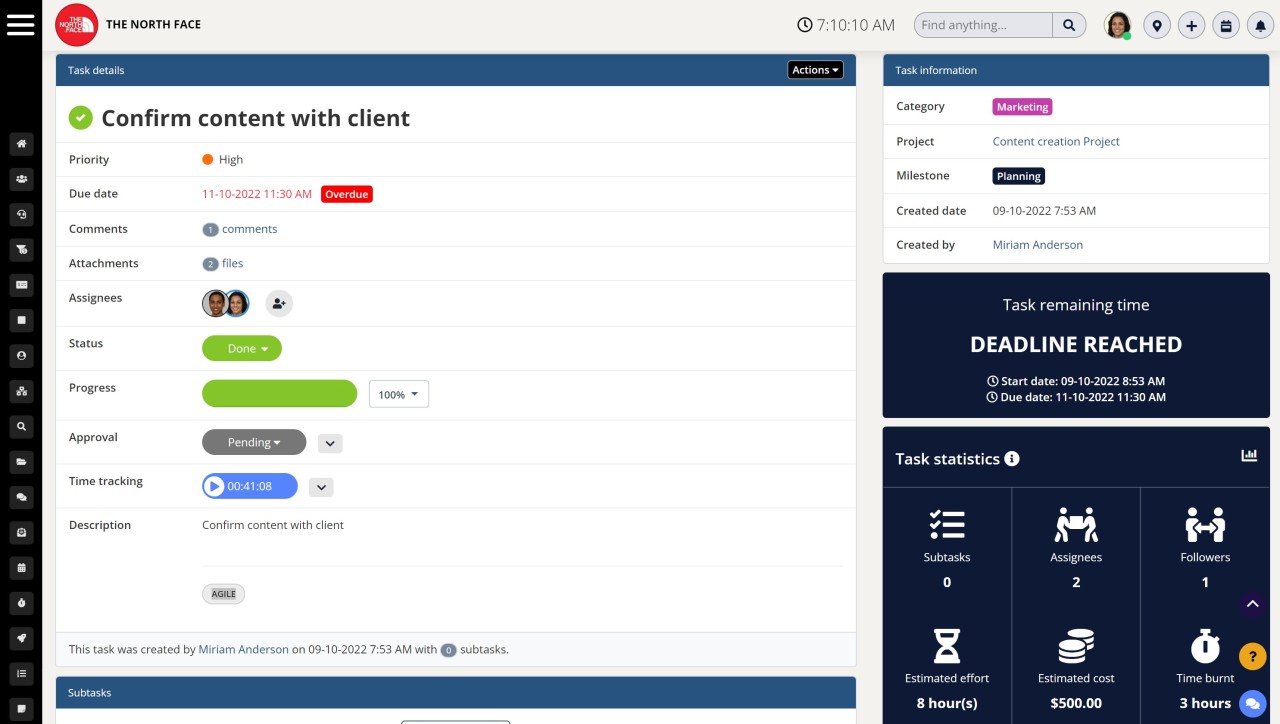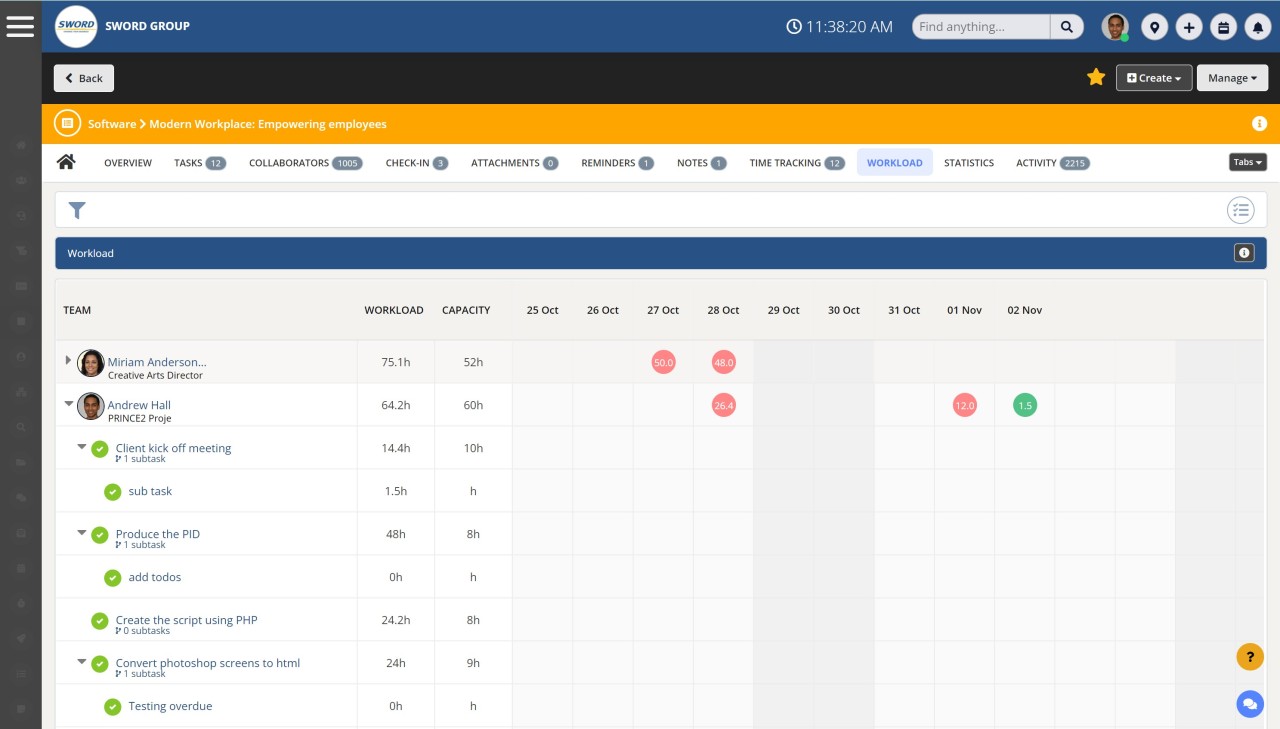Insight Blog
Agility’s perspectives on transforming the employee's experience throughout remote transformation using connected enterprise tools.
7 minutes reading time
(1444 words)
How can project managers improve resource utilization? A complete guide
Maximize profitable utilization– Project managers can forecast and improve billable and strategic resource utilization
Here are some fundamental when it comes to project management it's to maximize the use of all available resources, including the time of team members. While there are a few different ways to calculate resource utilization, the most fundamental and widely used method involves simply dividing the number of hours an available resource was actually used by the number of available work hours. In addition, managers also need to focus on employee utilization rates and profitability reports.
Effective resource management and a healthy return on investment depend on striking the right balance between billable work and downtime. And the missing link in that juggling act? Achieving expert-level skills in making use of available resources.
Utilization is defined as the amount of billable time can you pull out of the total available time of your employees.
Client vs. total time is a simple but effective way of monitoring employee productivity. By tracking the time spent working for clients, you can get a clear picture of how your employees are performing. This information is invaluable for making decisions about staffing, projects, and deadlines.
There are many benefits to client vs. total time tracking. It can help you improve employee productivity, communication, and accountability. It can also help you identify areas where employees need more training or support. If you want to take your project management to the next level, then client vs. total time tracking is the way to go.
To what extent does resource utilization differ from resource allocation?
Resource utilization and resource allocation are two important concepts in project management. Resource utilization refers to the actual amount of resources used during the execution of a project. Resource allocation, on the other hand, is the process of assigning resources to specific tasks and activities.
While resource utilization may differ from resource allocation, both concepts are important in ensuring the successful completion of a project. Proper resource utilization can help ensure that a project is completed on time and within budget, while proper resource allocation can help ensure that all tasks and activities are properly assigned and executed.
While resource utilization may differ from resource allocation, both concepts are important in ensuring the successful completion of a project. Proper resource utilization can help ensure that a project is completed on time and within budget, while proper resource allocation can help ensure that all tasks and activities are properly assigned and executed.
Project managers need to carefully consider both resource utilization and resource allocation when planning and executing a project. By understanding how these two concepts work, they can ensure that their projects are well-organized and run smoothly from start to finish.
Resource utilization
Resource utilization is a metric for gauging the efficacy of resource allocation by contrasting billable and non-billable time spent by a team. The success of a project is greatly influenced by how well its resources are utilized.
It is considered to be perfect if it is between 70 and 80% capacity. Afterward, workers have time for things like personal development, exploration of their own creativity, and much-needed downtime—20-30% of their total workweek.
Overuse and underuse should be avoided at all costs. Excessive utilization increases the likelihood that the project will be completed late or poorly. By doing this, you also raise the possibility that employees will become burned out and eventually leave.
Underutilization, on the other hand, can lead to missed deadlines. And if you have to pull people off one project and put them on another, they might get angry. If you told the decorator you didn't need any help, you might end up hanging up ornaments as guests arrive. If you realized an hour beforehand that you actually do need your friend's help, you could call them, and they might agree but be annoyed that they don't have time to run errands beforehand.
Resource allocation
Allocating resources means allocating and managing assets in a way that helps an organization achieve its strategic objectives. Allocating resources entails taking care of hard assets like hardware so that soft assets like human capital can shine. Allocating resources effectively entails weighing various demands and settling on a strategy that makes the most of available means while maximizing productivity and profit.
Before allocating resources, businesses should decide what they hope to achieve, be it more money, more output, or more name recognition. Next, they need to determine how much money, time, and other assets will be required to accomplish their objective.
What is the project management employee utilization rate?
Project management employee utilization rates are a way to quantify the ratio of revenue generated per unit of available bandwidth over a given time period, and thus an individual's efficiency and productivity. An employee utilization rate is the proportion of their available work hours that are actually billed to customers.
By dividing the number of billable hours worked by a team member by the number of available hours, you can get an idea of their utilization rate.
What is the importance of employee utilization rate?
Employees' interests and output may change as a result of monitoring their utilization. Employee utilization rate reveals whether workers are overworked or underutilized, which is important to avoid a negative impact on productivity. Employees can be fairly compensated for the time they spend on productive work. Employee performance, both good and bad, is exposed. Finding the void allows you to fill it and improve processes everywhere you look.
Use of employee utilization report
Managers may examine resource consumption on an individual level throughout the whole resource pool with the help of an employee utilization report. This is useful for pinpointing the time spent on a certain project by a given team member over a specified period of time.
Employee utilization reports may show you who is in demand, when they are needed most, and what projects have the longest administrative tails.
Project managers and other corporate decision-makers may use the information in a monthly employment utilization report to confidently prepare for the future. Planning future projects and other work is made easier by knowing in advance how much capacity team members have at any one moment. It provides real-time usage rates for resources across the organization, which is especially helpful in situations where quick choices are required, such as when a delay or block is unexpectedly encountered.
Use of profitability report in project management
One of the primary motivations behind starting a project is the opportunity to generate a financial gain. Every business owner wants his or her company to be profitable. Thus, it is fairly obvious that studying profitability report carefully is important for evaluating business growth. The true picture of your company's profits, however, will emerge once you peel back the layers of nuance that cover up the numbers on your financial statements. The profitability of your business can be tracked by examining the money left over after all expenses have been deducted from the initial investment.
How can resource management software help you to improve resource utilization?
Resource management software like AgilityPortal is a tool that helps businesses to better understand and manage their resource usage. By tracking how resources are being used, businesses can identify areas where there is potential for improvement.
For example, if a business is finds that its employees are regularly working overtime, it may be possible to adjust staffing levels or work schedules to improve utilization. In addition, resource management software can help businesses to allocate resources more effectively.
For example, if a business has a limited budget for marketing, it can use the software to track which marketing activities are yielding the most results and focus its resources on those activities. By improving resource utilization, businesses can save money, increase efficiency, and better support their growth goals.
It is tedious and difficult to track utilization rates of available resources using a manual method, such as a spreadsheet. Software for managing resources can help you save time and ensure that your employee information is correct. You'll be able to make more choices that promote efficient use of resources as a result.
Overusing and underusing resources can be avoided with the help of a resource management system, which provides clear, comprehensive visibility into workloads and resource availability. With the constantly updated data, more accurate resource projections for future endeavors can be made.
Conclusion
Employee burnout can be mitigated through better project management. Managers can use productivity data, employee utilization reports, and a well-thought-out strategy for maximizing the use of available resources. They also need to check the profitability reports and understand when and what resources to allocate to certain activities. Ultimately, it can also boost profits. In addition, resource management software can help to make a plan and adapt it according to the situation.
Categories
Blog
(2592)
Business Management
(318)
Employee Engagement
(205)
Digital Transformation
(172)
Intranets
(119)
Growth
(118)
Remote Work
(61)
Sales
(48)
Collaboration
(37)
Culture
(29)
Project management
(29)
Customer Experience
(26)
Knowledge Management
(21)
Leadership
(20)
Comparisons
(5)
Ready to learn more? 👍
One platform to optimize, manage and track all of your teams. Your new digital workplace is a click away. 🚀
Free for 14 days, no credit card required.

















